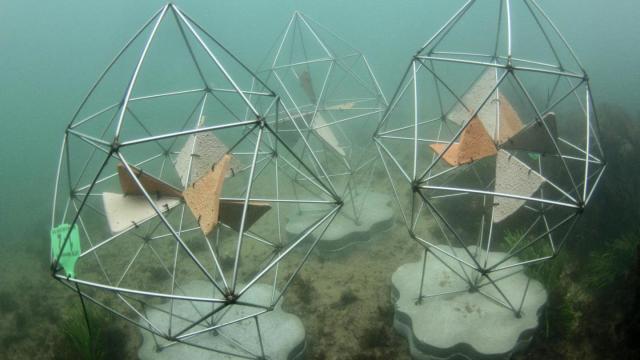The Sydney Opera House is a dope-arse work of architecture. Nestled along Sydney Harbour, the building is a sight to see. Now, the sea wall at Bennelong Point, where the opera house sits, features 18 hexagonal-shaped steel frames meant to serve as artificial coral reefs.
The University of Technology Sydney led this project, which began about three years ago, and finally made its big launch on Wednesday to coincide with World Environment Day.
The idea behind these cool-looking manmade reefs is to help boost fish biodiversity. The instalment follows years of research from scientists of the University of Technology Sydney and the University of Sydney, who confirmed that marine animals such as bream fish and octopus are attracted to these pods after just a few weeks of their entering the waters.
“We will continue to monitor the reefs and adjacent sites to document change and how effective adding small fish habitat structures is in enhancing fish life on seawalls,” said David Booth, a marine ecology professor at the University of Technology Sydney who worked on the project, in an academic release. “We hope it is a model for other cities on harbours.”
The New South Wales Environmental Trust provided the group with an $86,000 grant for the research, which involved having the artificial reefs designed and crafted. Reef Design Lab, which is behind the world’s largest 3D-printed artificial reef in the Maldives that measures 2.5m tall, built these reef pods out of steel and concrete.
The opera house’s sea wall will have eight pods, each of which hosts three of the actual reef-imitating pieces shaped like a somewhat confusing jungle gym. Eventually, the ocean should take over, covering them in seaweed to make them home for some unsuspecting sea critters.
Sydney Harbour has suffers serious pollution from microplastics and heavy metals, according to a government report from 2015. The Sydney Opera House is trying to play its part in improving the harbour it calls home.
Artificial reefs are nothing new: Sunken ships have been used as artificial reefs off the coast of Florida since at least the 1980s to help encourage coral growth. Offshore wind farms and oil rigs can play a similar role by offering surfaces for coral larvae to settle and develop into reefs.
As humans leave our mark throughout our oceans, these artificial creations may be able to help save corals in a world where we’re continuously killing them.
